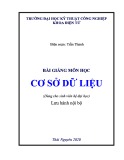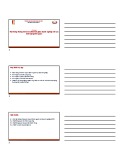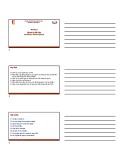
Ch ng 12ươ
Transaction Management
1

10.1 Transactions
•Concurrent execution of user programs is
essential for good DBMS performance.
–Because disk accesses are frequent, and
relatively slow, it is important to keep the cpu
humming by working on several user
programs concurrently.
•A user’s program may carry out many
operations on the data retrieved from the
database, but the DBMS is only concerned
about what data is read/written from/to the
database.
2

10.2 Transaction ACID
Properties
•Atomic
–Either all actions are carried out or none are.
–Not worry about incomplete transaction.
•Consistency
–DBMS assumes that the consistency holds for
each transaction.
•Isolation
–Transactions are isolated, or protected, from
the effects of concurrently scheduling other
transactions.
3

10.3 Concurrency in a DBMS
•Users submit transactions, and can think
of each transaction as executing by itself.
–Concurrency is achieved by the DBMS,
which interleaves actions (reads/writes of DB
objects) of various transactions.
–Each transaction must leave the database in a
consistent state if the DB is consistent when
the transaction begins.
•DBMS will enforce some ICs, depending on the
ICs declared in CREATE TABLE statements.
4

10.3 Concurrency in a DBMS
•Beyond this, the DBMS does not really understand
the semantics of the data. (e.g., it does not
understand how the interest on a bank account is
computed).
•Issues: Effect of interleaving transactions,
and crashes.
5


![Tài liệu học tập Hệ thống thông tin quản lý [mới nhất, đầy đủ]](https://cdn.tailieu.vn/images/document/thumbnail/2025/20250716/vijiraiya/135x160/512_tai-lieu-hoc-tap-he-thong-thong-tin-quan-ly.jpg)























